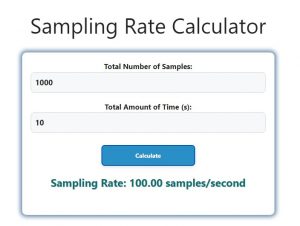About Sampling Rate Calculator (Formula)
In digital signal processing, the sampling rate is a crucial parameter that defines how frequently a continuous signal is sampled. Understanding and calculating the sampling rate is essential for applications in audio, video, and other forms of data processing. A sampling rate calculator allows you to easily determine the sample rate of a signal based on the number of samples taken and the total duration of the signal. This article will explain the formula used, guide you on how to use the calculator, provide an example, and address frequently asked questions related to sampling rates.
Formula
The formula for calculating the sampling rate is:
SMR = S / T,
where SMR is the sampling rate in samples per second (Hz), S is the total number of samples, and T is the total duration of the signal in seconds.
How to Use
Using a sampling rate calculator is straightforward. Follow these steps:
- Determine the Total Number of Samples (S): Count the number of samples you have taken from the signal.
- Measure the Total Duration (T): Determine the total duration of the signal in seconds.
- Input Values: Enter the values for the total number of samples and the total duration into the calculator.
- Calculate Sampling Rate: The calculator will compute the sampling rate using the provided values.
Example
Let’s say you have recorded 1,000 audio samples over a total duration of 10 seconds.
- Total Number of Samples (S): 1,000 samples
- Total Duration (T): 10 seconds
Now, using the formula:
SMR = S / T
SMR = 1,000 samples / 10 s
SMR = 100 samples per second (Hz)
Thus, the sampling rate of the audio signal is 100 Hz.

FAQs
1. What is sampling rate?
The sampling rate is the number of samples taken from a continuous signal per second, measured in Hertz (Hz).
2. Why is sampling rate important?
Sampling rate is crucial because it determines the fidelity and quality of the reconstructed signal. A higher sampling rate typically leads to better sound or image quality.
3. What happens if the sampling rate is too low?
If the sampling rate is too low, it can result in aliasing, where high-frequency components of the signal are misrepresented in the sampled data.
4. How do I choose the right sampling rate?
The sampling rate should be at least twice the highest frequency present in the signal, according to the Nyquist theorem.
5. Can I use this calculator for video signals?
Yes, the sampling rate calculator can be used for any type of signal, including audio and video, as long as you have the number of samples and duration.
6. How can I measure the total number of samples?
The total number of samples can be determined from the data acquisition device or software used to record the signal.
7. What is the difference between sampling rate and bit depth?
Sampling rate refers to how often a signal is sampled, while bit depth refers to the number of bits used to represent each sample, affecting dynamic range and detail.
8. What is the standard audio sampling rate?
Common audio sampling rates include 44.1 kHz (CD quality), 48 kHz (professional audio), and 96 kHz (high-resolution audio).
9. What is the impact of a higher sampling rate?
A higher sampling rate captures more detail in the signal, resulting in better sound quality but larger file sizes.
10. Can I convert audio files with different sampling rates?
Yes, audio files with different sampling rates can be converted, but it’s essential to consider quality loss and possible artifacts.
11. How does sample rate affect latency?
A higher sampling rate can reduce latency, but it may require more processing power and resources.
12. Is there a maximum sampling rate?
While there isn’t a strict maximum, practical limits exist based on the capabilities of the recording equipment and the human perception of sound.
13. How can I avoid aliasing when sampling?
To avoid aliasing, ensure the sampling rate is at least twice the highest frequency component of the signal (Nyquist rate).
14. What are common sampling rates for video?
Common video sampling rates include 24 fps (film), 30 fps (TV), and 60 fps (high-frame-rate video).
15. Can I change the sampling rate after recording?
Yes, you can change the sampling rate during post-processing, but it may lead to quality loss if not done correctly.
16. How do analog-to-digital converters relate to sampling rates?
Analog-to-digital converters (ADCs) convert continuous signals into discrete samples, and their performance is critical for achieving the desired sampling rate.
17. What software can I use to analyze sampling rates?
Many digital audio workstations (DAWs) and signal processing software can analyze and calculate sampling rates.
18. How can I verify the sampling rate of a recorded signal?
You can check the sampling rate in the metadata of the audio or video file or use audio analysis software.
19. Is the sampling rate the same for all audio formats?
No, different audio formats may have different standard sampling rates, affecting compatibility and quality.
20. How do different sampling rates affect file sizes?
Higher sampling rates typically result in larger file sizes due to the increased amount of data captured per second.
Conclusion
A sampling rate calculator is a valuable tool for anyone working with digital signals, whether in audio, video, or other applications. By understanding how to calculate the sampling rate using the total number of samples and the duration of the signal, you can ensure that your recordings meet the required quality standards. Mastering sampling rates enhances your ability to work effectively with digital data, making it an essential skill for professionals in various fields.